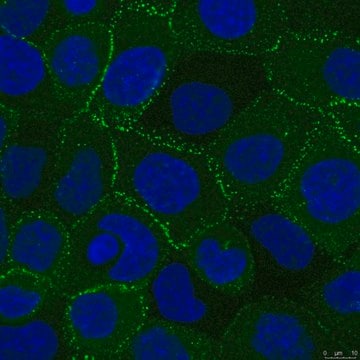R8761
Nco I from Nocardia corallina
Restriction Enzyme
Se connecterpour consulter vos tarifs contractuels et ceux de votre entreprise/organisme
About This Item
Numéro CAS:
Numéro MDL:
Code UNSPSC :
12352204
Produits recommandés
Qualité
for molecular biology
Forme
buffered aqueous glycerol solution
Concentration
10,000 units/mL
Conditions d'expédition
wet ice
Température de stockage
−20°C
Vous recherchez des produits similaires ? Visite Guide de comparaison des produits
Spécificité
Recognition sequence: 5′-C/CATGG-3′
Cutting results: a 2-10-fold Nco I overdigestion of 1 μg λ DNA substrate results in 100% cutting
Heat inactivation: Inactivated at 65 °C for 15 minutes.
Cutting results: a 2-10-fold Nco I overdigestion of 1 μg λ DNA substrate results in 100% cutting
Heat inactivation: Inactivated at 65 °C for 15 minutes.
Application
NcoI is a DNA restriction endonuclease that is used in molecular biology applications to cleave the DNA recognition site 5′-C/CATGG-3′, resulting in DNA fragments with 5′-cohesive termini.
Autres remarques
Supplied with 10x Restriction Enzyme Buffer SH (B3657).
Forme physique
Solution in 20 mM Tris-HCl, pH 8.0 , 0.1 mM EDTA, 100 mM NaCl, 10 mM 2-mercaptoethanol, 50% glycerol (v/v), 0.2%Triton X-100 (v/v) at 4 °C
Produit(s) apparenté(s)
Code de la classe de stockage
12 - Non Combustible Liquids
Classe de danger pour l'eau (WGK)
WGK 2
Point d'éclair (°F)
Not applicable
Point d'éclair (°C)
Not applicable
Certificats d'analyse (COA)
Recherchez un Certificats d'analyse (COA) en saisissant le numéro de lot du produit. Les numéros de lot figurent sur l'étiquette du produit après les mots "Lot" ou "Batch".
Déjà en possession de ce produit ?
Retrouvez la documentation relative aux produits que vous avez récemment achetés dans la Bibliothèque de documents.
Jonathan V Reddy et al.
Molecular biology of the cell, 17(10), 4353-4363 (2006-08-04)
Mannose 6-phosphate receptors (MPRs) deliver newly synthesized lysosomal enzymes to endosomes and then recycle to the Golgi. MPR recycling requires Rab9 GTPase; Rab9 recruits the cytosolic adaptor TIP47 and enhances its ability to bind to MPR cytoplasmic domains during transport
E M Van Cott et al.
Gene, 74(1), 55-59 (1988-12-25)
Methyltransferase genes from the FnuDI, NaeI, NcoI, and XbaI restriction-modification systems have been isolated in Escherichia coli by 'shot-gun' cloning bacterial DNA fragments into plasmid vectors and selecting for protectively modified molecules that resist digestion by the corresponding restriction endonuclease.
Retargeting of human T cells to tumor-associated MUC1: the evolution of a chimeric antigen receptor.
Scott Wilkie et al.
Journal of immunology (Baltimore, Md. : 1950), 180(7), 4901-4909 (2008-03-21)
MUC1 is a highly attractive immunotherapeutic target owing to increased expression, altered glycosylation, and loss of polarity in >80% of human cancers. To exploit this, we have constructed a panel of chimeric Ag receptors (CAR) that bind selectively to tumor-associated
C Kessler et al.
Gene, 92(1-2), 1-248 (1990-08-16)
The properties and sources of all known class-I, class-II and class-III restriction endonucleases (ENases) and DNA modification methyltransferases (MTases) are listed and newly subclassified according to their sequence specificity. In addition, the enzymes are distinguished in a novel manner according
Nico Mitro et al.
Methods in molecular biology (Clifton, N.J.), 952, 137-144 (2012-10-27)
The role of certain amino acids in the interactions of ligands with their cognate nuclear receptors is usually achieved by the resolution of the crystal structure of the receptor complexed with the ligand. As a complementary functional approach, site-directed mutagenesis
Notre équipe de scientifiques dispose d'une expérience dans tous les secteurs de la recherche, notamment en sciences de la vie, science des matériaux, synthèse chimique, chromatographie, analyse et dans de nombreux autres domaines..
Contacter notre Service technique





